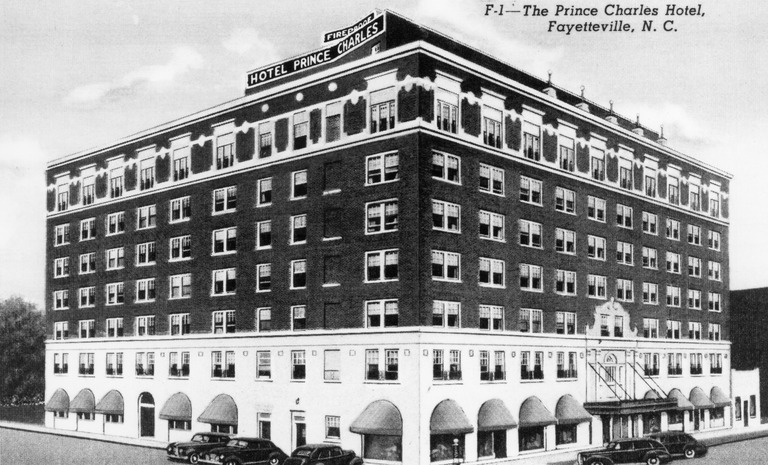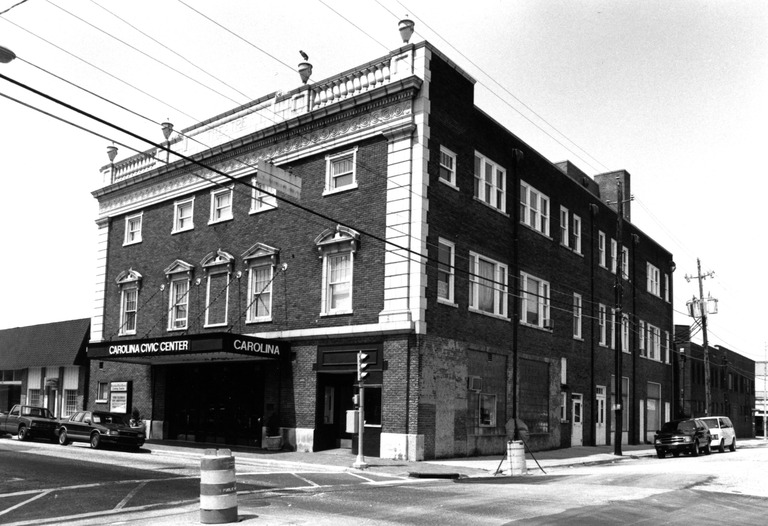Dixon, Stiles S. (1891-1936)
Variant Name(s):
Stiles Sedberry Dixon
Birthplace:
Fayetteville, North Carolina, NC
Residences:
- Fayetteville, North Carolina
Trades:
- Architect
NC Work Locations:
Building Types:
Styles & Forms:
Beaux-Arts Classical
Stiles S. Dixon (November 18, 1891-October 25, 1936) was an architect active in Fayetteville and nearby communities during the early 20th century. He was considered Fayetteville’s leading architect for several years. His work, alone or in collaboration with other architects, includes some of Fayetteville’s most notable buildings of the 1920s including the Cumberland County Courthouse and the Prince Charles Hotel as well as public schools and private residences. Working in the popular styles and forms of the day, he typifies the numerous early 20th century architects who helped define the architecture of their home communities.
Stiles Sedberry Dixon was a son of Arthur E. and Elizabeth Sedberry Dixon of Fayetteville. Arthur E. Dixon, variously identified as a native of Kansas and California, reportedly came to Fayetteville as a young man and became a locomotive engineer and manager of an ice company. Elizabeth Sedberry Dixon was part of an established Fayetteville family. Stiles Dixon, named for his maternal uncle, Henry Stiles Sedberry, was educated at local schools before attending the University of North Carolina and the University of Pennsylvania. He married Vida Dickinson of Wilmington, N. C. in 1915. In 1913 and again in 1919, he was listed in the Fayetteville City Directory as a bookkeeper at the Fayetteville Ice and Manufacturing Company, where his father was the manager. His pre-1920 architectural work has not been identified.
The Fayetteville Observer of February 10, 1920, carried an announcement that Wilmington architect Henry E. Bonitz was opening a branch office in Fayetteville, which was to be managed by Stiles S. Dixon. Of Dixon, the notice said only that he had “much practical experience in the offices of successful architects.” The United States Census of 1920 listed him as an architect and head of a household that included his wife Vida and young sons Arthur and Charles. (In 1930 his household also included sons Stiles S., Jr., and John.) Stiles Dixon was identified as the architect for the Huske Building “soon to go up on Hay street” in Fayetteville. In 1921 the Fayetteville Observer of November 24, reported that Dixon had been elected to membership in the (national) American Institute of Architects. During the 1920s he undertook major projects in Fayetteville and beyond.
In 1922, the Wilmington Star of June 30 and other newspapers announced that construction was soon to begin on “the first skyscraper in Fayetteville,” to house the National Bank of Fayetteville and stand 10 to 12 stories tall in a prominent spot on the northwest corner of Market Square, the center of the town. The architects were identified as William G. Rogers [Willard G. Rogers] of Charlotte and Stiles S. Dixon of Fayetteville. The Charlotte Observer of June 29, 1922, also reported on the proposed bank and noted that Dixon was also the architect for a proposed Fayetteville Elks Lodge on Hay Street and Old Street; the fate of the Elks project is unknown. Evidently the 1922 bank project encountered problems and was not completed at that time; it appears that the commission was shifted to Greensboro architect Charles C. Hartmann, who designed the 10-story building constructed in 1923-1926.
Meanwhile, according to the Wilmington Star of December 23, 1923, Dixon had associated with architect Harry Barton of Greensboro as architects for the new Cumberland County Courthouse, an imposing Beaux-Arts Classical edifice in pale gray stone. The same article also noted that Stiles was also “now collaborating with Willard G. Rogers, of Charlotte, in designing the plans for the new Prince Charles Hotel to be erected at Fayetteville,” a 7-story brick building sponsored by local investors to serve the growing demand from travelers on the rail and highway route to Florida. Also during the 1920s Dixon gained commissions to plan local public schools, including Massey Hill School , Seventy-First School, Stedman School, Linden School, and Gray’s Creek School. For him as for many other architects, the school consolidation construction campaigns of the 1920s provided bread and butter work and produced architect-designed schools according to state standards. His projects also included several residences, such as the Frank H. Stedman House of 1925.
He also won commissions beyond Fayetteville, of which one of the most prominent was the Carolina Theatre (1927-1928) in Lumberton, a 3-story, brick building with elaborate classical detail.
Dixon gained a noteworthy clientele in the Sandhills resort area of Moore County, not far from Fayetteville, where his designs included both formal and informal residences in Pinehurst and Southern Pines, typically elaborate year-round vacation homes for wealthy northerners, such as the Lloyd-Howe House in Pinehurst. He was one of several notable North Carolina and northern architects who designed the communities’ architecture. Stiles’s brother Frederick Dixon was a managing partner in the regional construction firm of Reinecke and Dixon, which built the Lloyd-Howe House and others in Pinehurst.
His career was cut short by his death at age 43 of tuberculosis. The Wilmington Star of October 26, 1936 identified Stiles S. Dixon as a “prominent Fayetteville architect” who had designed “a number of outstanding buildings in Fayetteville, including the Cumberland County Courthouse and the Prince Charles Hotel.” He was survived by his wife, Vida and his children, siblings, and parents. He was buried at Cross Creek Cemetery in Fayetteville.
- Fayetteville Observer, October 26, 1936.
- Michelle Ann Michael, “Massey Hill School,” National Register of Historic Places nomination (2004).
- John Alexander Oates, The Story of Fayetteville and the Upper Cape Fear (1950, 1972).
Carolina Theatre
Contributors:Stiles S. Dixon, architect; H. A. Underwood Construction Co., contractorsDates:1927-1928
Location:Lumberton, Robeson CountyStreet Address:319 N. Chestnut St., Lumberton
Status:Standing
Type:Commercial
Note:A landmark of downtown Lumberton, the brick building with Italian Renaissance classical details hosted vaudeville and other live shows as well as moving pictures. See Davyd Foard Hood and Edward F. Turberg, Carolina Theatre National Register nomination (1980). The theatre closed in 1975 but has been renovated as the Carolina Civic Center.
Charles H. Pray House
Contributors:Stiles S. Dixon, architectDates:1930
Location:Pinehurst, Moore CountyStreet Address:45 Blue Rd., Pinehurst, NC
Status:Standing
Type:Residential
Note:The large, formal Colonial Revival house contrasts with the informality of the Lloyd-Howe House and shows Dixon’s flexibility in stylistic matters to suit his clientele.
Cumberland County Courthouse
Contributors:Dates:1924-1926
Location:Fayetteville, Cumberland CountyStreet Address:Intersection of Franklin St., Gillespie St., and Russell St., Fayetteville, NC
Status:Standing
Type:Public
Images Published In:Catherine W. Bishir and Michael T. Southern, A Guide to the Historic Architecture of Eastern North Carolina (1996).
Frank H. Stedman House
Contributors:Stiles S. Dixon, architectDates:1925
Location:Fayetteville, Cumberland CountyStreet Address:1516 Morganton Rd., Fayetteville, NC
Status:Standing
Type:Residential
Note:The Renaissance Revival style residence, built for a prominent local businessman and banker, is the sole example of that style in Fayetteville.
Lloyd-Howe House
Contributors:Stiles S. Dixon, architect; Reinecke and Dixon, contractorsDates:1929
Location:Pinehurst, Moore CountyStreet Address:Quail Run SE of Linden Rd., Pinehurst, NC
Status:Standing
Type:Residential
Note:The large, rambling house combines motifs of the New England Cape Cod mode and the log cabin in a well-crafted “rustic” style. Like many residences in the Sandhills resort communities, it has a very large living and dining area opening to terraces. It was built as a year-round vacation home for Mr. and Mrs. John Bross Lloyd and was part of an estate developed around horseback riding. There were other houses in Pinehurst planned by Dixon. Stiles Dixon’s brother, Frederick S. Dixon, was a managing partner in the contracting firm of Reinecke and Dixon, which had a regional clientele. See Claudia Roberts (Brown), “Lloyd-Howe House”, National Register of Historic Places nomination, 1983.
Massey Hill School
Contributors:Stiles S. Dixon, architectDates:1925
Location:Fayetteville, Cumberland CountyStreet Address:1062 Southern Ave., Fayetteville, NC
Status:Standing
Type:Educational
Note:The Fayetteville Observer of February 12, 1924, identified Stiles S. Dixon as the architect of the Massey Hill School as well as the concurrent Seventy-First School. Both were products of the movement toward consolidated schools.
National Bank of Fayetteville
Contributors:Stiles S. Dixon, architect; Willard G. Rogers, architectDates:1922
Location:Fayetteville, Cumberland CountyStreet Address:Fayetteville, NC
Status:Unbuilt
Type:Commercial
Note:Among the projects cited to Rogers in the Manufacturers’ Record was the 13-story National Bank in Fayetteville, in association with Stiles S. Dixon (Manufacturers’ Record July 13, 1922). The Fayetteville Observer reported on June 27 that the company planned to build a 10 or 12-story bank, and that on display was a picture of a bank building “drawn by Willard G. Rogers of Charlotte and Stiles S. Dixon of Fayetteville, and presented to the bank,” giving an idea of the future building. This project evidently stalled. A short time later, the 10-story National Bank of Fayetteville (1923-1926) was built from designs by Charles C. Hartmann of Greensboro. The building was 10 stories tall. Whether the 1922 design influenced its design is unknown.
Prince Charles Hotel
Contributors:Stiles S. Dixon, architect; Willard G. Rogers, architectDates:1923-1925
Location:Fayetteville, Cumberland CountyStreet Address:430 Hay St., Fayetteville, NC
Status:Standing
Type:Commercial
Images Published In:Catherine W. Bishir and Michael T. Southern, A Guide to the Historic Architecture of Eastern North Carolina (1996).
Note:The large hotel is typical of the era in fireproof construction covered in red brick with classical details. It was named for “Bonnie Prince Charlie,” the figure much celebrated in local lore in a county and region settled by Highland Scots in the 18th century.
Seventy-First School
Contributors:Stiles S. Dixon, architectDates:1924
Location:Fayetteville, Cumberland CountyStreet Address:6830 Raeford Rd., Fayetteville, NC
Status:Standing
Type:Educational
Note:The brick school features the simplified Collegiate Gothic style of educational architecture widely used in the 1910s and 1920s. Remarkably intact inside and out, it has wings added in 1938 and 1949. During the consolidation era of the early 20th century, six one-room county schools in western Cumberland County were consolidated as Seventy-First School. It was cited in the January 5, 1924 Fayetteville Observer and predicted to be “a work of architectural and construction art.” The school was named for the township it served, which in turn was named for the 71st Highland Regiment, a Scottish regiment at the Battle of Culloden in 1746, at which Prince Charles and his Scots troops were defeated. Local history reports that members of the regiment were among the Highland Scots who settled in western Cumberland County in the 18th century. Highland Scots history remains an important part of the county’s heritage.
Thomas S. Wheeler House
Contributors:Stiles S. Dixon, architectDates:1929
Location:Pinehurst, Moore CountyStreet Address:70 Midland Rd.
Status:Standing
Type:Residential
Note:The L-shaped house features wood-shingled walls and Colonial Revival details.



